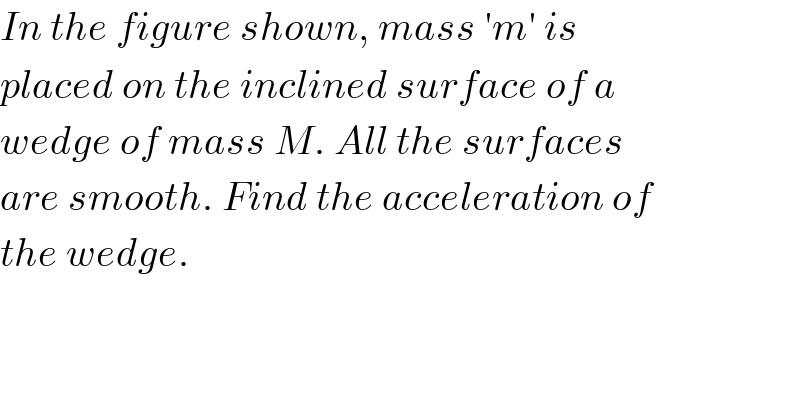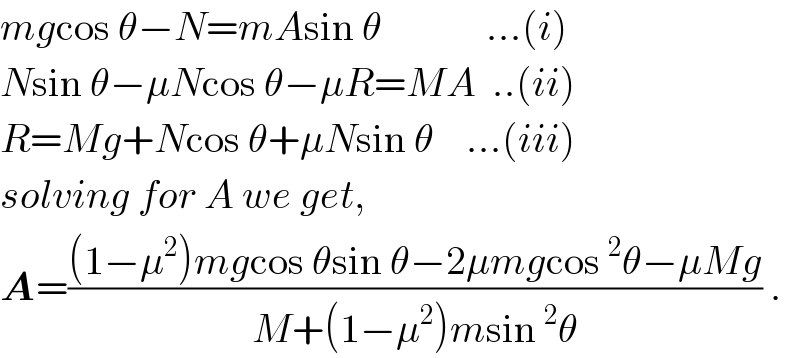
Question Number 20777 by Tinkutara last updated on 02/Sep/17

$${In}\:{the}\:{figure}\:{shown},\:{mass}\:'{m}'\:{is} \\ $$$${placed}\:{on}\:{the}\:{inclined}\:{surface}\:{of}\:{a} \\ $$$${wedge}\:{of}\:{mass}\:{M}.\:{All}\:{the}\:{surfaces} \\ $$$${are}\:{smooth}.\:{Find}\:{the}\:{acceleration}\:{of} \\ $$$${the}\:{wedge}. \\ $$
Commented by Tinkutara last updated on 02/Sep/17

Commented by ajfour last updated on 02/Sep/17

$${N}\mathrm{sin}\:\theta={MA}\:\:\:..\left({i}\right) \\ $$$${mg}\mathrm{cos}\:\theta−{N}={mA}\mathrm{sin}\:\theta \\ $$$${or}\:\:{using}\:\left({i}\right) \\ $$$${mg}\mathrm{cos}\:\theta\mathrm{sin}\:\theta−{MA}={mA}\mathrm{sin}\:^{\mathrm{2}} \theta \\ $$$$\:\:\Rightarrow\:\:\:\boldsymbol{{A}}=\frac{\boldsymbol{{mg}}\mathrm{sin}\:\boldsymbol{\theta}\mathrm{cos}\:\boldsymbol{\theta}}{\boldsymbol{{M}}+\boldsymbol{{m}}\mathrm{sin}\:^{\mathrm{2}} \boldsymbol{\theta}}\:. \\ $$
Commented by Tinkutara last updated on 02/Sep/17

$$\mathrm{Thank}\:\mathrm{you}\:\mathrm{very}\:\mathrm{much}\:\mathrm{Sir}! \\ $$
Commented by mrW1 last updated on 03/Sep/17

$$\mathrm{what}\:\mathrm{is}\:\mathrm{the}\:\mathrm{result}\:\mathrm{if}\:\mathrm{the}\:\mathrm{friction}\:\mathrm{coe}.\:\mathrm{of}\:\mathrm{all} \\ $$$$\mathrm{surfaces}\:\mathrm{is}\:\mu? \\ $$
Commented by ajfour last updated on 03/Sep/17

Commented by ajfour last updated on 03/Sep/17

$${mg}\mathrm{cos}\:\theta−{N}={mA}\mathrm{sin}\:\theta\:\:\:\:\:\:\:\:\:\:\:\:\:...\left({i}\right) \\ $$$${N}\mathrm{sin}\:\theta−\mu{N}\mathrm{cos}\:\theta−\mu{R}={MA}\:\:..\left({ii}\right) \\ $$$${R}={Mg}+{N}\mathrm{cos}\:\theta+\mu{N}\mathrm{sin}\:\theta\:\:\:\:...\left({iii}\right) \\ $$$${solving}\:{for}\:{A}\:{we}\:{get}, \\ $$$$\boldsymbol{{A}}=\frac{\left(\mathrm{1}−\mu^{\mathrm{2}} \right){mg}\mathrm{cos}\:\theta\mathrm{sin}\:\theta−\mathrm{2}\mu{mg}\mathrm{cos}\:^{\mathrm{2}} \theta−\mu{Mg}}{{M}+\left(\mathrm{1}−\mu^{\mathrm{2}} \right){m}\mathrm{sin}\:^{\mathrm{2}} \theta}\:. \\ $$
